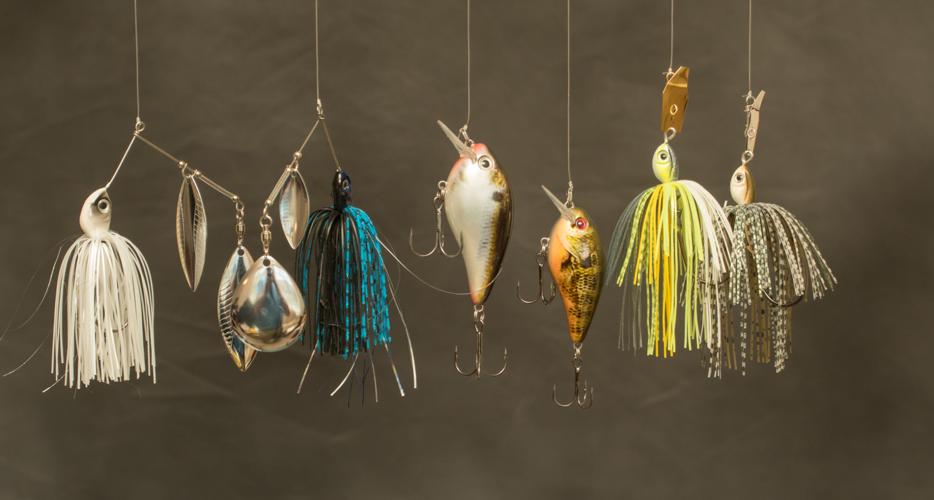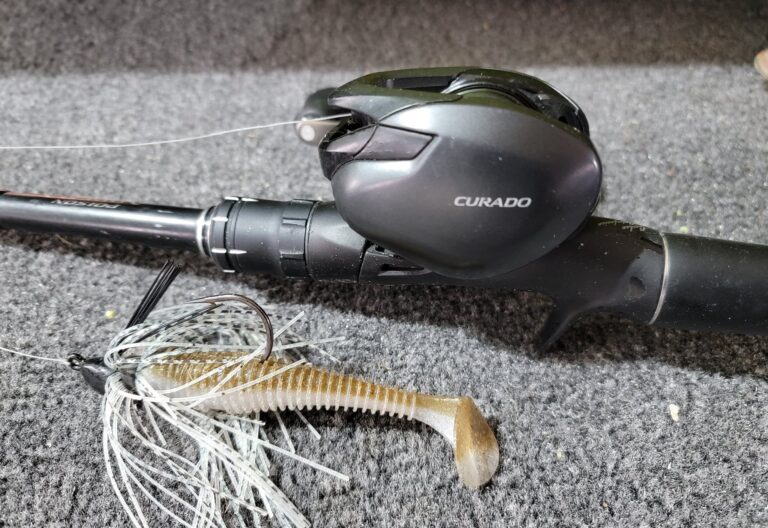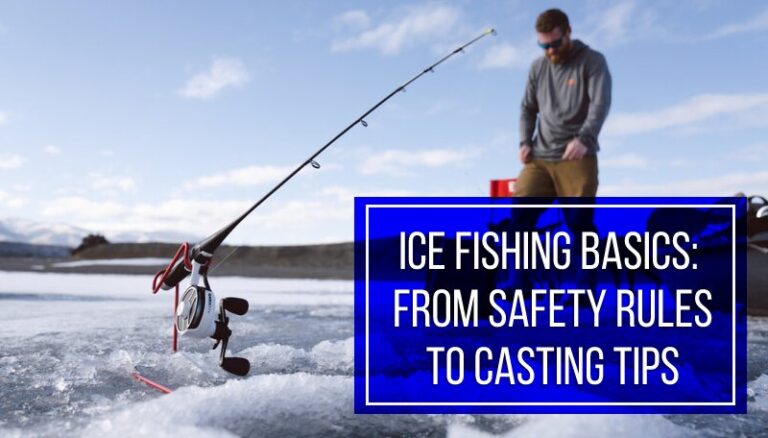Some popular color patterns for spinning lures include bright colors like chartreuse and orange, as well as natural patterns such as silver and gold. These color choices are highly effective in attracting fish and increasing the chances of a successful catch.
When it comes to selecting the right color pattern for a spinning lure, it’s crucial to consider the water conditions, local fish species, and personal fishing preferences. By using vibrant and contrasting colors, anglers can create a visual appeal that triggers the instinctual response in fish, making them more likely to strike the lure.
Incorporating these color patterns into spinning lures can significantly enhance fishing success and make the angling experience more enjoyable.

Credit: www.wvgazettemail.com
Understanding The Importance Of Color In Spinning Lures
Spinning lures come in a wide variety of colors, each designed to attract fish in different ways. The role of color in spinning lures is crucial as it can greatly influence a fish’s decision to strike. Fish are visually-oriented creatures, and their ability to perceive color underwater is an important factor to consider when choosing the right lure.
Let’s delve into the fascinating world of color patterns and how they affect your chances of success.
The Role Of Color In Attracting Fish
Colors play a significant role in luring fish towards your spinning lure. Here are some key points to understand:
- Different color patterns can mimic various prey species, attracting fish that commonly feed on them.
- Vibrant and contrasting colors can grab a fish’s attention, especially in murky water or low-light conditions.
- Certain colors like red and orange are known to stimulate aggressive behaviors in fish, triggering strikes.
- Matching the color of the lure to the natural prey found in the water body you’re fishing can increase your chances of success.
How Fish Perceive Color Underwater
Fish have a unique way of perceiving color underwater. Here are some fascinating insights:
- Fish have a limited ability to see colors, and their vision differs from humans.
- They rely on their cones, specialized photoreceptor cells, to perceive color.
- Cones in a fish’s eye are primarily sensitive to blue and green light, with some species having an additional sensitivity to uv light.
- Fish can perceive different shades and intensities of colors, which affect their response to spinning lures.
Factors To Consider When Choosing Color Patterns For Spinning Lures
Selecting the right color patterns for your spinning lures can make a significant difference in your fishing success. Consider the following factors:
- Water clarity: In clear water, natural and more subtle color patterns tend to work well, while in murky or stained water, brighter colors with high contrast can be more effective.
- Time of day: Adjust your color choices based on the time of day you’re fishing. Bright and vibrant colors work best during daylight hours, while darker or more natural-colored lures are suitable for dawn or dusk fishing.
- Target species: Different fish species have distinct preferences for colors. Research the prey species they commonly feed on and choose spinning lures that mimic those colors.
Remember, there is no one-size-fits-all answer when it comes to choosing color patterns for spinning lures. It’s essential to experiment with different colors and observe how fish respond to them in different fishing conditions. So, next time you’re out on the water, pay attention to the colors you choose for your spinning lures and see how they can make a significant impact on your fishing success.
Naturalistic Color Patterns
Mimicking The Appearance Of Natural Prey
- Spinning lures are designed to attract fish by mimicking the appearance of natural prey.
- By imitating the colors and patterns of various preys, anglers can increase their chances of luring fish to bite.
- Naturalistic color patterns are especially effective when targeting predatory fish that feed on smaller prey species.
Using Earth Tones And Realistic Patterns
- Earth tones such as browns, greens, and grays are commonly used in naturalistic color patterns for spinning lures.
- These colors blend in with the natural surroundings, making the lure appear more realistic.
- Realistic patterns such as spots, stripes, and scales further enhance the lure’s resemblance to actual prey.
- Using earth tones and realistic patterns can fool fish into believing that the spinning lure is a genuine source of food.
The Effectiveness Of Naturalistic Color Patterns In Different Fishing Conditions
- Naturalistic color patterns tend to perform well in a variety of fishing conditions.
- In clear water, these patterns can be highly effective in fooling fish that have a clear view of their surroundings.
- In murky or stained water, naturalistic color patterns can still be effective as they provide a realistic silhouette.
- However, it’s important to consider the specific conditions and the type of prey species you are targeting when selecting a color pattern.
High-Contrast Color Patterns
Utilizing Bright, Bold Colors To Catch Fish’S Attention
When it comes to spinning lures, one of the key factors that can attract fish is the color pattern. Bright and bold colors are often utilized to catch the fish’s attention and entice them to strike. Here are some key points to consider when using high-contrast color patterns for spinning lures:
- Bright and bold colors such as red, orange, yellow, and chartreuse are often preferred for their visibility underwater.
- These vibrant colors create a striking contrast against the natural backdrop of the water, making the spinning lure stand out.
- The contrast helps to grab the fish’s attention quickly and can trigger their predatory instincts, leading to more bites.
- High-contrast color patterns work effectively in both clear and murky waters, as they are easily distinguishable even in low visibility conditions.
Creating Contrast Between The Lure And The Environment
Another critical aspect of high-contrast color patterns is creating a stark contrast between the spinning lure and its surrounding environment. This contrast can make the lure more noticeable and enticing for fish. Consider the following points when trying to create contrast:
- Opt for colors that sharply contrast with the water conditions and the prevalent hues in the fish’s habitat.
- For example, using a dark-colored spinning lure, such as black or brown, in clear water can create an eye-catching contrast.
- In murky or stained water, lighter colors like white or fluorescent shades can help the lure stand out against the darker backdrop.
- Experiment with different color combinations to find the one that offers the most significant contrast in a specific fishing environment.
Remember, the goal is to make the spinning lure stand out from its surroundings, attracting the attention of nearby fish.
Overall, high-contrast color patterns are most effective when they catch fish’s attention, utilizing bright, bold colors, and creating contrast between the lure and the environment. By employing these techniques, you can increase your chances of success and bring in more fish while spinning.
So go ahead, experiment with different color patterns, and find the perfect combination that will entice those elusive catches.
Flashy And Vibrant Color Patterns
Spinning lures with flashy and vibrant color patterns are highly effective in attracting fish and triggering aggressive strikes. These color patterns mimic the appearance of injured or vulnerable prey, making them irresistible to predatory fish. In this section, we will explore the key elements and advantages of incorporating metallic or iridescent elements, as well as how flashy and vibrant color patterns enhance visibility and excel in specific fishing situations.
Incorporating Metallic Or Iridescent Elements
When designing spinning lures with flashy and vibrant color patterns, incorporating metallic or iridescent elements can significantly enhance their effectiveness. Here are the key points to consider:
- Metallic or iridescent elements create eye-catching flashes of light, mimicking the scales or movements of a distressed baitfish. These flashes attract the attention of predatory fish and trigger their instinctual response to strike.
- Silver, gold, and other metallic shades are commonly used in spinning lures to imitate baitfish that reflect light as they swim. This realistic representation can trick fish into believing that an easy meal is available, leading them to strike.
- Iridescence refers to the property of appearing to change color as the angle of view or the angle of light changes. Spinning lures with iridescent elements mimic the natural color variations of baitfish, making them more enticing to target species.
Enhancing Visibility And Attracting Aggressive Strikes
Flashy and vibrant color patterns on spinning lures not only enhance visibility but also help attract aggressive strikes from fish. Here are the key points to understand:
- Bright colors such as chartreuse, orange, and red are highly visible in both clear and murky water conditions. They stand out against the natural surroundings, grabbing the attention of predatory fish from a distance.
- These vibrant color patterns create a stark contrast against dull or dark environments, making the spinning lure more noticeable and intriguing to fish. The sudden appearance of a brightly colored lure can trigger their curiosity and provoke aggressive strikes.
- Uv-enhanced or fluorescent color patterns are also popular for spinning lures. Underwater, these colors become even more vivid due to the way light penetrates the water. Fish can see these enhanced colors better than humans, increasing the lure’s attractiveness and drawing them in for a strike.
Fishing Situations Where Flashy And Vibrant Color Patterns Excel
Flashy and vibrant color patterns are particularly effective in certain fishing situations. Understanding when to utilize these color patterns can significantly improve your chances of success. Here are the key points to consider:
- Spinning lures with flashy and vibrant color patterns excel in low light conditions such as dawn and dusk when visibility is reduced. The bright colors help compensate for reduced visibility and make the lure more noticeable to fish.
- Murky or stained water is another fishing situation where flashy and vibrant color patterns shine. The contrast provided by these colors helps the lure stand out in water with reduced clarity, increasing its visibility and enticing fish to strike.
- Fishing in areas with dense vegetation or structures can also benefit from flashy and vibrant color patterns. The bright colors can help the lure stand out against the backdrop of vegetation or structure, making it easier for fish to spot and increasing their chances of striking.
By incorporating metallic or iridescent elements, enhancing visibility, and excelling in specific fishing situations, flashy and vibrant color patterns on spinning lures can be a game-changer for your angling success. Experiment with different color combinations and patterns to find what works best for your target species and fishing conditions.
Remember, a well-presented spinning lure with an attention-grabbing color pattern can entice even the most cautious fish into biting.
Water Clarity And Light Conditions
Adapting Lure Color Based On Water Clarity
When it comes to choosing the right color pattern for your spinning lures, one crucial factor to consider is the water clarity. The clarity of the water can greatly affect how fish perceive the colors of your lures. To increase your chances of success, it’s essential to adapt your lure color according to the water conditions.
Here are some key points to keep in mind:
- Clear water:
- In clear water, fish have a clearer view of their surroundings, making them more cautious. To entice their attention, choose natural-looking colors that mimic prey. Opt for shades of green, brown, and silver to blend in seamlessly with the water.
- Stained water:
- In stained or slightly murky water, visibility is reduced, and fish rely more on their other senses to detect prey. Use more vibrant and contrasting colors that can attract their attention amidst the murky background. Bright shades of yellow, chartreuse, orange, and red are excellent choices.
- Muddy or turbid water:
- In muddy or turbid water, visibility is significantly limited, and fish rely primarily on their sense of vibration and sound to locate prey. Opt for lures with a larger profile and high contrast colors that can create vibrations and draw attention. Dark colors such as black, brown, and dark blue are effective in these conditions.
The Impact Of Light Penetration On Color Perception
Light penetration plays a crucial role in how colors are perceived underwater. As light travels through the water, it gets absorbed, and certain colors are filtered out. This can affect the visibility and effectiveness of your lure colors. Consider the following points:
- Ultraviolet (uv) light:
- Uv light penetrates deeper into the water than other colors, making lures with uv-enhanced colors more visible to fish. Incorporating uv-reflective materials or using lures specifically designed to highlight uv colors can increase your chances of attracting fish.
- Daylight conditions:
- During bright daylight conditions, natural light is abundant, and fish can see colors more accurately. Stick to natural color patterns that mimic the prey in the area. Imitating baitfish or insects with realistic greens, silvers, and browns will yield better results.
- Low light conditions:
- In low light conditions such as dawn, dusk, or cloudy days, visibility is reduced, and fish rely on more contrast. Choose lures with high contrasting colors to stand out in dim light. Vibrant colors like orange, chartreuse, and fluorescent shades can be highly effective during these times.
Best Color Choices For Different Water Conditions And Times Of Day
To summarize, here are some recommended color choices based on different water conditions and times of day:
- Clear water:
- Natural colors like green, brown, and silver.
- Stained water:
- Vibrant colors like yellow, chartreuse, orange, and red.
- Muddy or turbid water:
- Dark colors like black, brown, and dark blue.
- Ultraviolet (uv) light:
- Uv-enhanced colors visible to fish.
- Daylight conditions:
- Natural color patterns mimicking local prey.
- Low light conditions:
- High contrasting colors like orange, chartreuse, and fluorescent shades.
Tailoring your lure color selection to the water clarity and light conditions can significantly improve your chances of enticing fish to strike. Experimenting with different color combinations and observing the fish’s response will help you determine the most effective color patterns for your spinning lures.
Seasonal Color Preferences
Understanding How Seasonal Changes Affect Fish Behavior
Fish behavior is heavily influenced by seasonal changes, which in turn affects their color preferences when it comes to spinning lures. Understanding these behavioral patterns can vastly improve your success rate as an angler. Here are a few key points to consider:
- Fish tend to be more active during certain seasons, such as spring and fall, when water temperature is favorable for feeding and spawning. This increased activity level makes them more likely to strike a spinning lure.
- In warmer months, fish often seek refuge in shady areas or deeper waters to escape the heat. This means that lures with darker color patterns, resembling natural prey found in these areas, are more likely to entice a strike.
- As the seasons change, fish species may transition from feeding on insects to feeding on small fish. Adjusting your lure color patterns to match the prevalent prey species during a particular season can significantly increase your chances of success.
Adjusting Color Patterns To Match Prey Species And Natural Surroundings
Matching your spinning lure color patterns to the prevalent prey species and natural surroundings is vital for attracting fish. Here are some tips to keep in mind:
- Research the local fish species and their preferred prey. For example, if the target species primarily feed on small minnows, using lures with silver and white color patterns can mimic the appearance of these prey species.
- Pay attention to the natural surroundings, such as vegetation, water clarity, and bottom composition. Lures with green and brown color patterns can blend into these environments and mimic the appearance of vegetation or small crustaceans.
- Consider the water depth and light conditions. In deeper or murky waters, lures with vibrant colors like chartreuse or fluorescent pink can provide better visibility and attract fish from a distance.
Recommended Color Patterns For Each Season
To maximize your chances of success, it’s important to match your spinning lure color patterns to the specific season. Here are some recommended color patterns for each season:
Spring:
- Bright and vibrant colors like chartreuse, orange, or red can mimic the appearance of spawning fish or attract the attention of aggressive predators.
- Natural earth tones like brown or green can imitate the emerging vegetation, appealing to fish seeking food and shelter.
Summer:
- Darker colors like black, blue, or purple can replicate the appearance of larger prey species, which fish are more likely to target during this season.
- Metallic colors like silver or gold can reflect light and attract fish, particularly in bright and sunny conditions.
Fall:
- Natural colors like brown, orange, or olive can imitate the changing foliage and appeal to fish accustomed to feeding on fallen insects.
- Red or firetiger patterns can imitate injured or dying prey, triggering a predator’s instinct to strike.
Winter:
- Natural colors like white, silver, or gray can resemble baitfish or small aquatic organisms that fish may still feed on during the colder months.
- Slow-moving lures with subtle color patterns can simulate the limited activity of prey in cold water, enticing lethargic fish.
By understanding fish behavior, adjusting color patterns to match prey species and natural surroundings, and utilizing the recommended color patterns for each season, you can significantly improve your chances of success when using spinning lures. Remember to experiment with different colors and techniques to find what works best in specific fishing situations.
Happy angling!
Regional And Species-Specific Color Preferences
When it comes to choosing the perfect color pattern for your spinning lures, considering regional and species-specific color preferences can make all the difference in attracting your target fish. Different fish species have varying color sensitivities and preferences, and understanding these factors can significantly improve your chances of success on the water.
Additionally, the geographic region and habitat you are fishing in can also influence the color patterns that will be most effective. Expert anglers and fisheries biologists have shared their insights on popular color choices for specific fish species, so let’s dive in and explore these considerations further.
Tailoring Color Patterns To Specific Fish Species
Understanding the color preferences of your target fish species is crucial for effective lure selection. Here are some key points to consider when tailoring color patterns to specific fish species:
- Different fish species perceive colors differently, with some having the ability to see certain colors better than others. For example, bass have excellent color vision and are known to respond well to vibrant and contrasting color patterns.
- Matching the lure color to the natural forage of the fish species you are targeting can greatly increase your chances of success. If the predominant forage in the area is silver minnows, using a silver-colored lure can be highly effective.
- Experimenting with different shades and hues of the same color can be beneficial. Fish may respond differently to varying color intensities and saturation levels, so be open to trying different shades to find the right combination.
- Pay attention to the time of day and water clarity when selecting your lure color. Bright and flashy colors may work better in low light conditions, while more natural and subdued colors can be effective in clear water.
Considerations For Different Geographic Regions And Habitats
Geographic regions and specific habitats can play a significant role in determining which color patterns are most appealing to fish. Here are some considerations to keep in mind:
- In murky or stained water, using lures with bright and highly visible color patterns can help fish locate and strike your bait more easily. Chartreuse, orange, and fluorescent colors often work well in these conditions.
- In clear water, it’s generally best to stick with more natural and realistic color patterns that mimic the local forage. Greens, browns, and silver are commonly effective in these circumstances.
- Certain regions may have specific color preferences based on local forage availability and historical success. Engaging with local anglers, bait shops, and guides can provide valuable insights into the most effective color patterns for a particular area.
Expert Insights On Popular Color Choices For Specific Fish Species
Expert anglers and fisheries biologists have shared their knowledge on popular color choices for specific fish species. Here are some valuable insights:
- For largemouth bass, popular color choices include watermelon red, green pumpkin, black/blue, and white. These colors mimic the prevalent forage and can trigger aggressive strikes.
- Trout are often attracted to neutrally-colored lures that imitate small baitfish, such as silver, white, and light pink. Natural tones like brown and olive can also be effective, especially in clear water.
- Walleye tend to respond well to bright and vibrant colors such as chartreuse, yellow, and orange. These colors can help catch their attention and trigger their predatory instincts.
- Crappie are known to be drawn to a variety of colors, including chartreuse, yellow, black, and white. Experimentation with different color patterns is often key to discovering their preferences.
Remember, while these popular color choices have proven successful, fish behavior can vary based on factors like weather conditions, water temperature, and fishing pressure. It’s essential to observe and adapt your color patterns accordingly to maximize your chances of success on the water.
Conclusion
Understanding color patterns in spinning lures is essential for any angler looking to increase their chances of success. By considering the environment and the behavior of fish, anglers can select the most effective color patterns for their lures. Bright and flashy colors like chartreuse and neon are great for low light conditions or murky water, while natural and subtle colors like brown and green mimic the appearance of natural prey.
Additionally, experimenting with contrasting color combinations such as red and white or black and yellow can trigger a predator’s instinct to strike. It is important to keep in mind that fish can have individual preferences, so it’s always a good idea to have a variety of colors in your tackle box.
By following these guidelines and continuously learning and adapting, anglers can maximize their chances of successful fishing trips.






